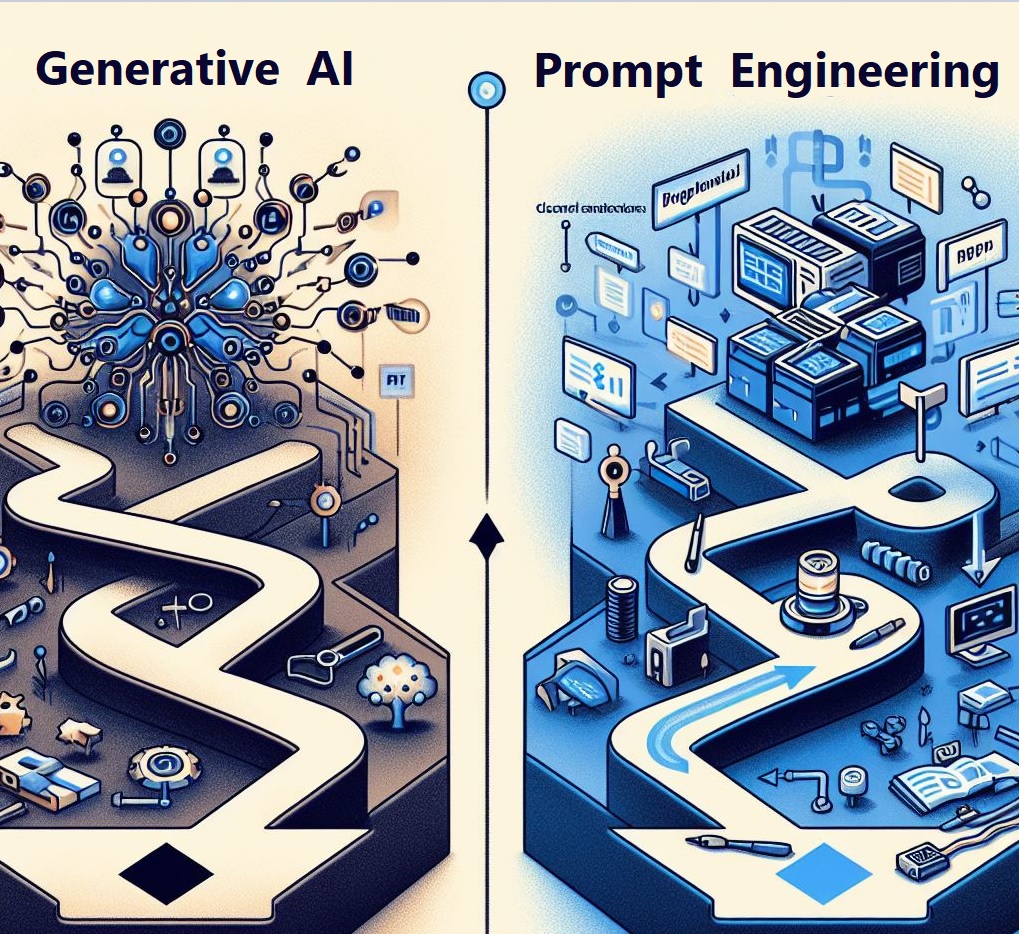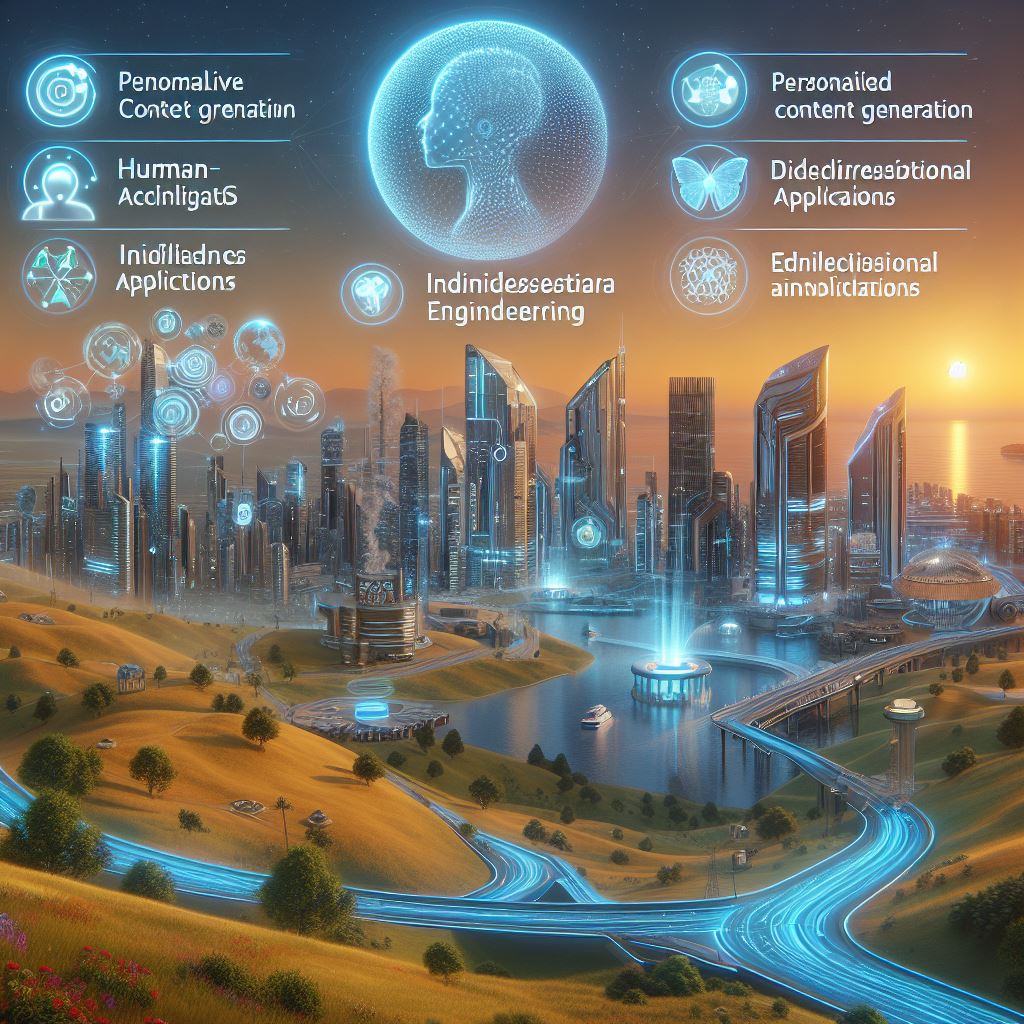Introduction to Generative AI: Unveiling the Power of Autonomous Creation
In the rapidly evolving landscape of artificial intelligence (AI), two prominent methodologies have emerged: generative AI and prompt engineering. These approaches hold the key to unlocking the potential of autonomous creation, revolutionizing industries ranging from content generation to product design.
In this article, we delve into the intricacies of generative AI and prompt engineering, exploring their differences, applications, and future implications. By the end, you’ll have a deeper understanding of these cutting-edge technologies and their role in shaping the future of AI-driven innovation.
1. Understanding the Differences Between Generative AI and Prompt Engineering.
Generative AI and prompt engineering are two distinct methodologies within the field of artificial intelligence, each with its unique approach and applications. Understanding the differences between these two is crucial for grasping their respective strengths and limitations.
Generative AI, also known as deep generative models, refers to AI systems capable of generating new data instances, such as images, text, or even music, that resemble real-world examples. These systems are often based on neural networks and employ techniques like generative adversarial networks (GANs) or variational autoencoders (VAEs). Generative AI operates autonomously, producing output without explicit instructions for each instance. Instead, it learns from a vast dataset and creates new content based on its learned patterns.
On the other hand, prompt engineering revolves around the idea of providing specific prompts or instructions to AI models to generate desired outputs. Rather than relying solely on learned patterns from data, prompt engineering involves crafting precise prompts or instructions to guide the AI model’s generation process. This approach allows for more fine-grained control over the generated content, enabling users to tailor outputs to their specific needs.
1.1. Key distinction between generative AI and prompt engineering: Autonomy.
One key distinction between generative AI and prompt engineering lies in their level of autonomy and control. Generative AI operates autonomously, generating content based on its learned patterns, which may result in a higher degree of creativity but less control over the output’s specifics. In contrast, prompt engineering provides users with more control over the generated content by guiding the AI model through explicit prompts or instructions, allowing for precise customization.
1.2. Another distinction: Training processes
Another difference is in their respective training processes. Generative AI models typically require extensive training on large datasets to learn the underlying patterns and distributions of the data. This training process can be computationally intensive and time-consuming but results in models capable of autonomously generating diverse and realistic content. Prompt engineering, on the other hand, involves crafting specific prompts or instructions tailored to the desired output, which may require less training data but relies heavily on the quality and specificity of the prompts.
In terms of applications,
- Generative AI finds use cases in various fields such as image generation, text generation, and creative content creation. It can be employed for tasks like generating realistic images from textual descriptions, creating human-like dialogue, or even composing music.
- Prompt engineering, on the other hand, is well-suited for tasks that require precise control over the generated output, such as text summarization, language translation, or fine-tuning language models for specific applications.
In summary, while both generative AI and prompt engineering are powerful approaches for content generation, they differ in their level of autonomy, control, and training processes.
- Generative AI operates autonomously based on learned patterns from data,
- while prompt engineering provides users with more control over the output through explicit prompts or instructions.
Understanding these differences is essential for leveraging the strengths of each approach in various AI applications.

Image for Understanding the Differences Between Generative AI and Prompt Engineering: An illustration showcasing two pathways diverging, one representing Generative AI with multiple arrows indicating autonomous creation, and the other depicting Prompt Engineering with clear instructions leading to the desired output, symbolizing control and specificity.
2. Applications and Use Cases of Generative AI
Generative AI, with its ability to autonomously create new data instances, has found a wide range of applications across various industries. Let’s explore some of the key use cases where generative AI is making significant contributions:
2.1. Image Generation:
One of the most well-known applications of generative AI is in image generation. Generative models like Generative Adversarial Networks (GANs) and Variational Autoencoders (VAEs) have been used to generate highly realistic images that resemble photographs of real-world scenes. These models can create new images based on learned patterns from large datasets, making them valuable tools for tasks like image synthesis, style transfer, and even image editing.
2.2. Text Generation:
Generative AI is also adept at generating human-like text, ranging from simple sentences to entire articles or stories. Language models such as OpenAI’s GPT (Generative Pre-trained Transformer) series are capable of generating coherent and contextually relevant text based on given prompts or starting phrases. Text generation models have applications in natural language processing tasks like text completion, dialogue generation, and content creation.
1.3. Creative Content Creation:
Beyond images and text, generative AI has been applied to various forms of creative content creation, including music, art, and design. AI-powered systems can compose music in different genres and styles, generate artwork in various mediums, and even design products or architectural layouts. These applications demonstrate the versatility of generative AI in fostering creativity and innovation across diverse domains.
1.4. Data Augmentation:
In fields like computer vision and natural language processing, generative AI is utilized for data augmentation, a technique used to increase the diversity and size of training datasets. By generating synthetic data instances that are similar to real-world examples, generative models help improve the robustness and generalization of machine learning models. This approach is particularly useful in scenarios where collecting large amounts of labeled data is challenging or expensive.
1.5. Drug Discovery and Molecular Design:
In the pharmaceutical industry, generative AI plays a crucial role in drug discovery and molecular design. AI-powered algorithms can generate novel molecular structures with desired properties, potentially leading to the discovery of new drugs and therapeutic compounds. By leveraging generative models, researchers can explore vast chemical spaces more efficiently and identify promising candidates for further experimental validation.
These are just a few examples of the diverse applications of generative AI across different domains. As the field continues to advance, we can expect to see even more innovative uses of generative models to tackle complex challenges and drive progress in various industries.

Image for Applications and Use Cases of Generative AI: A collage of diverse creations generated by AI, including vivid images, snippets of text, musical notes, and artistic compositions, highlighting the versatility and creativity of generative AI across various domains such as art, literature, music, and design.
3. Applications and Use Cases of Prompt Engineering
Prompt engineering, a methodology centered around providing specific prompts or instructions to AI models, offers a unique approach to content generation and interaction with artificial intelligence. Let’s delve into some of the key applications and use cases where prompt engineering is making significant strides:
- Text Summarization: One of the primary applications of prompt engineering is text summarization, where AI models are tasked with condensing large volumes of text into concise summaries. By providing a well-crafted prompt that specifies the summarization task and desired output length, prompt engineering enables AI models to generate summaries that capture the essential information from the input text. This approach is invaluable for tasks like document summarization, news article summarization, and content extraction from web pages.
- Language Translation: Prompt engineering is also instrumental in language translation tasks, where AI models are trained to translate text from one language to another. By providing clear and specific prompts that define the source and target languages, as well as the context of the translation task, prompt engineering facilitates accurate and contextually relevant translations. This approach allows for fine-tuning translation models to specific domains or language pairs, improving translation quality and fluency.
- Question Answering: Another use case for prompt engineering is question answering, where AI models are trained to answer questions based on given context or knowledge. By crafting prompts that provide the question along with relevant context or passages, prompt engineering enables AI models to generate accurate and informative answers. This approach is employed in various applications, including virtual assistants, customer support chatbots, and information retrieval systems.
- Code Generation: In the field of software development, prompt engineering is utilized for code generation tasks, where AI models are trained to generate code snippets or entire programs based on given requirements or specifications. By providing prompts that outline the desired functionality or behavior of the code, prompt engineering empowers AI models to produce code that meets the specified criteria. This approach is valuable for automating repetitive coding tasks, prototyping new software features, and generating code examples for educational purposes.
- Content Generation with Fine-grained Control: Unlike traditional generative AI approaches, which operate autonomously based on learned patterns from data, prompt engineering offers users finer control over the generated content. By crafting precise prompts that specify the desired attributes, style, or characteristics of the output, users can guide the AI model’s generation process and tailor the output to their specific needs. This level of control is particularly advantageous for tasks that require precise customization or adherence to specific requirements.
These are just a few examples of the diverse applications of prompt engineering across different domains. As the field continues to evolve, we can expect to see further advancements in prompt engineering techniques and their integration into various AI-driven applications.

Image for Applications and Use Cases of Prompt Engineering: A visualization illustrating the process of prompt engineering, with a user inputting specific prompts or instructions into an AI model, and the model generating tailored outputs in response, representing applications like text stigmatization, language translation, question answering, and code generation.
4. Future Trends and Implications for Generative AI and Prompt Engineering
As the fields of generative AI and prompt engineering continue to advance, several future trends and implications are shaping the landscape of artificial intelligence. Let’s explore some of these trends and their potential impact:
- Advancements in Model Capabilities: One of the key future trends in generative AI and prompt engineering is the ongoing advancements in model capabilities. As researchers develop more sophisticated algorithms and architectures, AI models are becoming increasingly capable of generating high-quality and contextually relevant content across various modalities, including text, images, and music. These advancements are driving innovation in areas such as creative content generation, natural language understanding, and human-computer interaction.
- Interdisciplinary Applications: Another emerging trend is the interdisciplinary applications of generative AI and prompt engineering. These methodologies are finding applications beyond traditional domains like computer science and engineering, spanning fields such as healthcare, finance, and education. For example, generative models are being used to generate synthetic medical images for training diagnostic algorithms, while prompt engineering is facilitating personalized learning experiences through adaptive content generation.
- Ethical and Societal Implications: With the increasing adoption of AI technologies in various domains, there is growing recognition of the ethical and societal implications associated with generative AI and prompt engineering. Concerns related to bias, fairness, and accountability in AI-generated content are prompting discussions around responsible AI development and deployment. Addressing these ethical considerations will be crucial for ensuring that AI technologies benefit society while minimizing potential harms.
- Human-AI Collaboration: Future trends also point towards enhanced collaboration between humans and AI systems. Generative AI and prompt engineering can empower users to co-create content with AI assistance, leveraging the strengths of both humans and machines. This collaborative approach has the potential to enhance creativity, productivity, and innovation across diverse domains, fostering a symbiotic relationship between humans and AI.
- Continued Research and Innovation: Finally, the future of generative AI and prompt engineering will be shaped by continued research and innovation in the field. Researchers are exploring new techniques, algorithms, and applications to push the boundaries of what AI can achieve. Areas of focus include improving model efficiency, scalability, and interpretability, as well as addressing challenges related to data privacy, security, and societal impact.
In summary, the future of generative AI and prompt engineering holds promise for driving innovation, addressing societal challenges, and transforming various industries. By staying abreast of emerging trends and ethical considerations, we can harness the potential of these technologies to create a more inclusive, collaborative, and sustainable future.

Image for Future Trends and Implications for Generative AI and Prompt Engineering: A futuristic landscape with AI-powered technologies seamlessly integrated into everyday life, depicting scenarios like personalized content generation, human-AI collaboration, interdisciplinary applications, and ethical considerations, symbolizing the evolving trends and implications of generative AI and prompt engineering.
5. Conclusion
Generative AI and prompt engineering represent two distinct yet complementary approaches to content generation and interaction with artificial intelligence. Throughout this article, we’ve explored the nuances of these methodologies, from their underlying principles to their diverse applications across various domains.
Generative AI, with its ability to autonomously create new data instances, offers unprecedented opportunities for creativity and innovation. From generating realistic images and human-like text to composing music and designing products, generative AI is pushing the boundaries of what AI can achieve. Its applications span a wide range of industries, from entertainment and marketing to healthcare and finance.
On the other hand, prompt engineering provides users with fine-grained control over the generated content, enabling precise customization and adaptation to specific requirements. By crafting clear and specific prompts, users can guide AI models to generate contextually relevant outputs, making prompt engineering invaluable for tasks like text stigmatization, language translation, and question answering.
Looking ahead, the future of generative AI and prompt engineering holds promise for driving further innovation and addressing societal challenges. As researchers continue to advance the state-of-the-art in AI algorithms and architectures, we can expect to see even more sophisticated models capable of generating high-quality and contextually relevant content across diverse modalities.
However, as we embrace the potential of these technologies, it’s essential to remain mindful of the ethical and societal implications associated with AI-generated content. Responsible AI development and deployment are paramount to ensuring that these technologies benefit society while minimizing potential harms.
In closing, generative AI and prompt engineering represent the forefront of AI-driven innovation, offering new ways to create, interact, and collaborate with artificial intelligence. By harnessing the power of these methodologies, we can unlock new possibilities and shape a future where humans and machines work together to achieve remarkable outcomes.

Image for Conclusion: An image of hands clasped together, representing the collaboration between humans and AI, surrounded by symbols of creativity, innovation, and ethical responsibility, signifying the harmonious partnership between humans and machines in shaping the future of AI-driven innovation.
Metadata keywords and phrases:
- Generative AI
- Prompt engineering
- Artificial intelligence
- Content generation
- Machine learning
- AI applications
- Future trends in AI
- Creative AI
- Ethical implications of AI
- Human-AI collaboration
Feature Image Description: A captivating illustration depicting the convergence of generative AI and prompt engineering, with dynamic swirls of color representing creativity and innovation. In the center, two intertwined gears symbolize the synergy between autonomous creation (Generative AI) and guided instruction (Prompt Engineering), illustrating the collaborative relationship between these methodologies in driving AI-driven content generation and interaction. This visually striking image encapsulates the essence of the article, inviting viewers to explore the dynamic interplay between technology and creativity in the realm of artificial intelligence.





Pingback: Prompt Engineering Demystified: Terrain of AI Interaction - Daily-On.Com